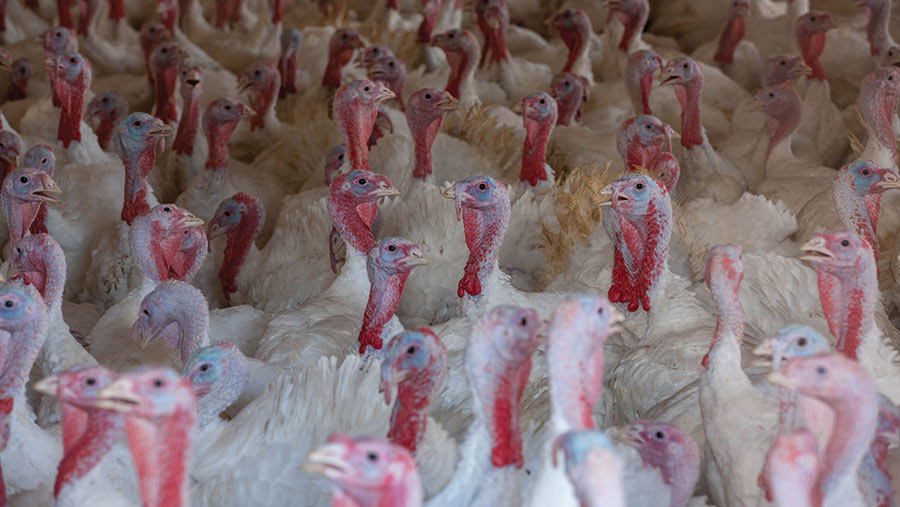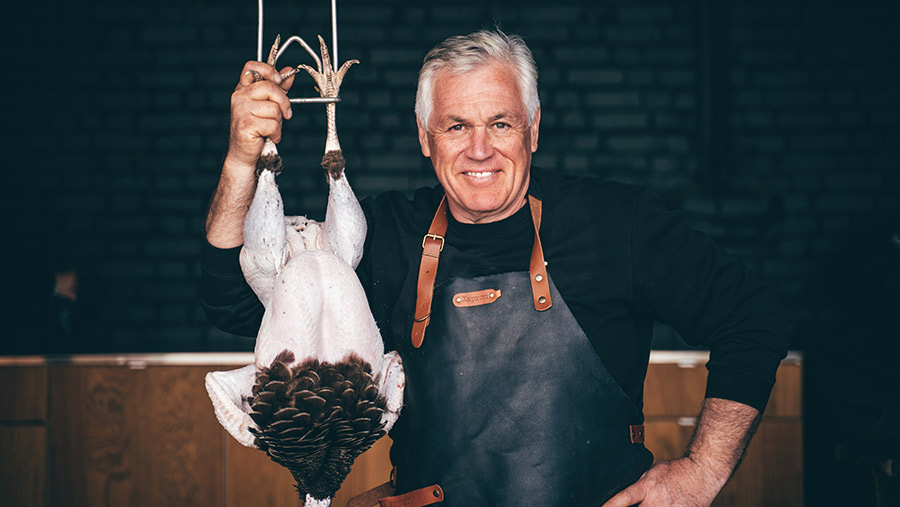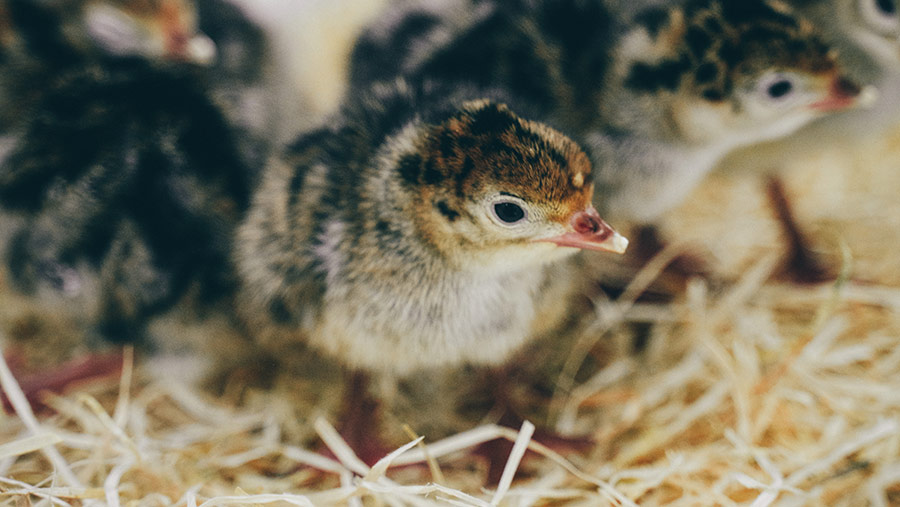Why turkeys need managing differently to broilers
 © Tim Scrivener
© Tim Scrivener Factors affecting choice of breed, age at slaughter, and brooding, rearing and disease management all have unique considerations for turkey production.
Regarding turkeys simply as big broilers could put a serious dent in flock performance and profitability.
In the UK, turkeys are either reared for commercial meat stripping, which produces cuts and processed meats for supermarkets year-round, or for Christmas as a whole bird.
The former are typically fast-growing, white-feathered strains of breed, while the latter are often slower-growing, bronze-feathered strains.
See also: 7 tips for making a profit from farm-scale Christmas turkeys
Right breed, right market
KellyBronze Turkeys and Farmgate Hatcheries produce about 30% (205,000) of the fresh turkeys sold at Christmas in the UK.
Of these, half are processed in-house, and include 35,000 very slow-growing, home-bred KellyBronze turkeys.
This breed needs to be grown to maturity to achieve its full weight and flavour, says managing director Paul Kelly. This makes it ideal for the premium market.
By contrast, the standard commercial breeds of turkey for meat stripping and breeding, bred by Aviagen Turkeys and Hendrix Turkeys, are the benchmark for efficient meat production, yield, and liveability in the commercial market.
“The commercial turkey is a very fast-growing bird that builds a big frame to be slaughtered at 20kg-plus for stags,” says Paul.
“It’s very feed efficient up to that point, with a feed conversion ratio [FCR] around 2.3:1 – although not as efficient as a broiler at 1.5:1.

Paul Kelly © Max Howard
“Achieving 20kg at 20 weeks is the optimum for meat yield versus food conversion in the commercial turkey.”
Unlike broilers, one breed does not suit the criteria for most markets, and a challenge is the use of commercial turkeys for cheaper Christmas turkey production.
“Because they lay down a big, heavy frame first, if you try and use them for Christmas turkey production at the popular weights (4-5kg), you end up having to kill the bird in its adolescence, when it is still in its skeletal growth stage,” he explains.
“The broad principles for rearing are exactly the same. It’s just about rearing the birds to the right maturity to get the finish on the carcass for your target market.”
Producing a range of weights to suit consumer demands, Paul’s bronze strains achieve, on average, 7.5kg liveweight, with processing at full maturity, at about 26 weeks of age.
FCR averages 4.5, with average concentrate feed intakes at about 250g a bird each day.
Rearing
Whether operating a brood-and-move system or a single placement system, the components of rearing will have a big impact on turkey performance.
As with broiler chicks, getting turkey poults off to a good start is crucial.
“Poults are a lot harder to start,” notes Paul. “Broiler chicks will be very active in seeking out food and water, whereas turkey poults are lazier and require food and water to be very close to them.
“Excellent hygiene, ventilation, litter management and stockmanship are crucial to success.”
Brooding
The most popular system for brooding is ring brooding.
For this, sheds should be set up with 4m-diameter brooding rings to accommodate up to 350 poults in each, advises Paul.
Each ring should be equipped with a brooder, and food and water points; six of each for every 350 poults.
House temperature should be about 25C, with the temperature under the brooder at a steady 35-37C.
Paul runs his brooders at 35.3C, and advises checking temperatures regularly to avoid big fluctuations.
After the first week, he reduces brooder temperatures by around by 1C every day to 15C.
“Between 15-18C is when you’re going to get the best feed conversion,” he adds.
Once brooding rings have been dismantled in the second week, stocking density should be 10 birds/sq m, and after five weeks, 2.5 birds/sq m.
In the first week, about 2% mortality is normal, increasing to 3% in the first fortnight – but poor ring layout and management could quickly escalate mortality to more than 5% in the first six days.
“Whole-house brooding is possible with turkeys; however, you must have excellent environmentally controlled buildings,” Paul stresses.
He gives his poults 12 hours of light and 12 hours of dark to provide sufficient periods of rest for healthier, happier birds.
“During periods of darkness, in intensive systems, you can keep a low light of about 15 lux to prevent spooking and cannibalism.”

© Max Howard
Nutrition
Over the course of their life, turkeys will transition through four to five different rations.
For the first five weeks, poults should be fed a high-quality, high-protein starter feed supplying 26-28% crude protein (CP), with adequate levels of lysine, methionine and cystine, and 11.9-12.2 MJ/kg of metabolisable energy.
Thereafter, turkeys should be fed rearing and then finishing pellets, ending on a 13-14% CP diet. Chicken feed should not be used as it will not meet their nutritional needs.
“All poultry will eat to their energy requirements,” says Paul.
“If you feed too much energy, then they won’t get the protein intakes for growth, and if you feed too little, then FCR will be poor – either way it’s a big cost.”
He advises working with a nutritionist to drill down on diets and using spot weighers to track daily liveweight gains and identify challenges.
Ranging
When reared in a natural cycle system, hatched in May/June, poults at around five weeks old can be introduced to the range in good weather.
Stocking density can be up to 2,500 birds/ha, but good range management and stockmanship is essential to reduce parasitic and predator risk.
There should be one feeder and one drinker for 100 birds – and Paul stocks his woodland turkeys at 494/ha.
Disease
Flock performance can be compromised significantly by disease. Enteritis is a big problem in turkeys – more so than in broilers.
“My opinion is that it’s particularly problematic when birds are pushed too hard and too quickly,” says Paul.
On the breeding side of his business, he supplies organic acids through the water lines to promote a healthy gut.
“On our meat side, we don’t give organic acids because we don’t put the birds under the stresses that come with more intensive systems.”
Organic acids, monoglycerides, prebiotics and probiotics can target problem areas or act as a preventative, and he suggests consulting a vet or nutritionist for advice.
Turkeys are also susceptible to respiratory disease, with a humid environment a big risk. Ensuring adequate air movement over housed birds is vital.
Biosecurity and good stockmanship are the most effective forms of defence against diseases, and getting the most out of the turkeys.
“With turkeys, you’re managing them for around 20 weeks, in environments that have greater variation than in a broiler system.
“To get the best performance out of your turkeys, you’ve really got to be on top of stockmanship – be observant and understand the turkeys’ behaviour, monitor intakes and weights – and act on observations.”
